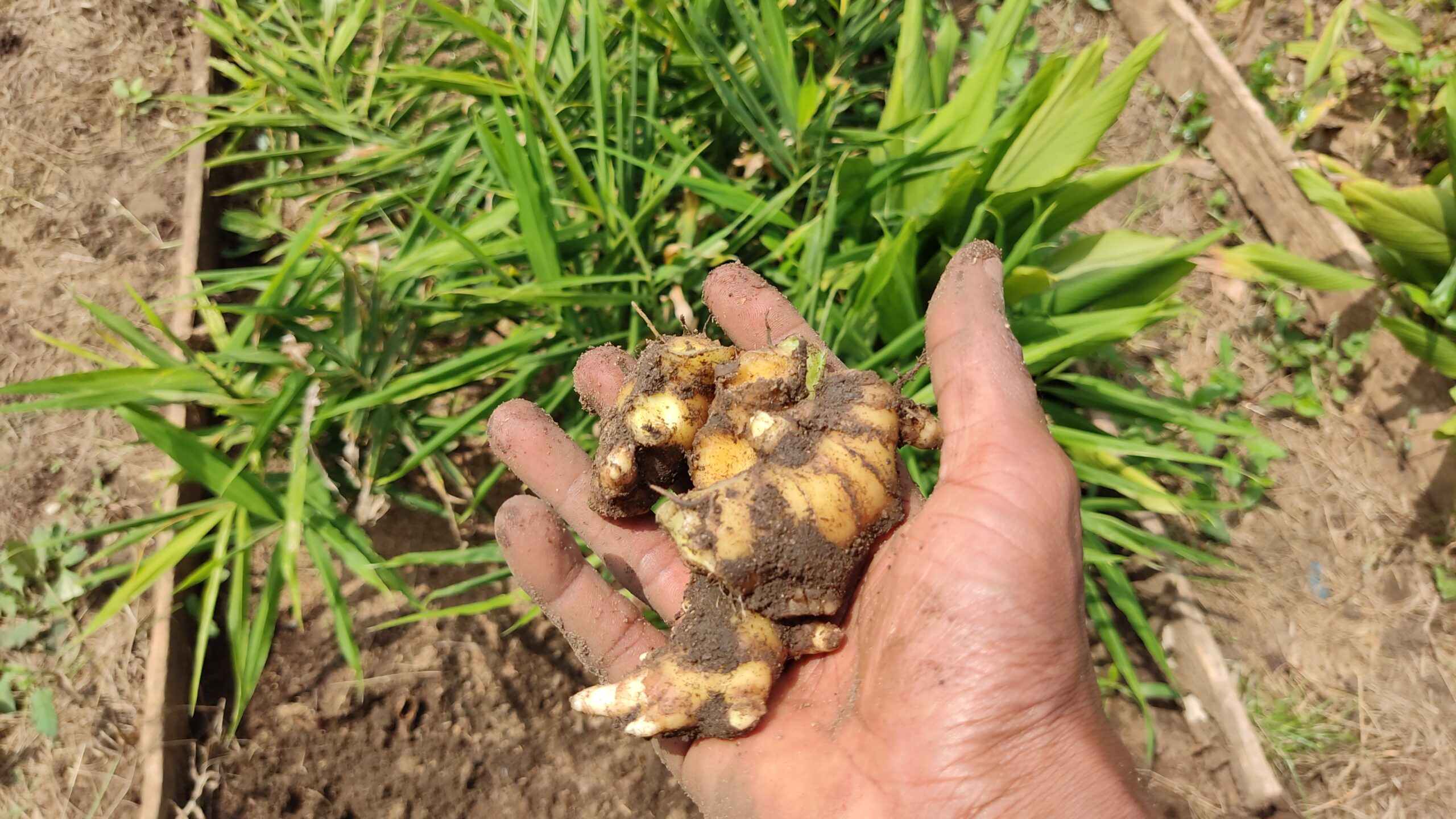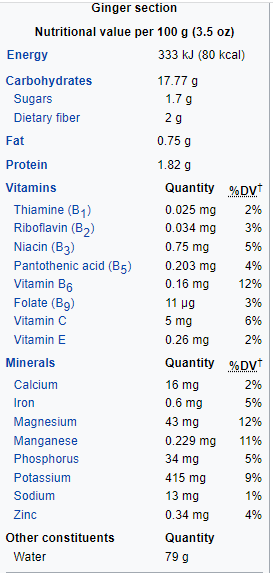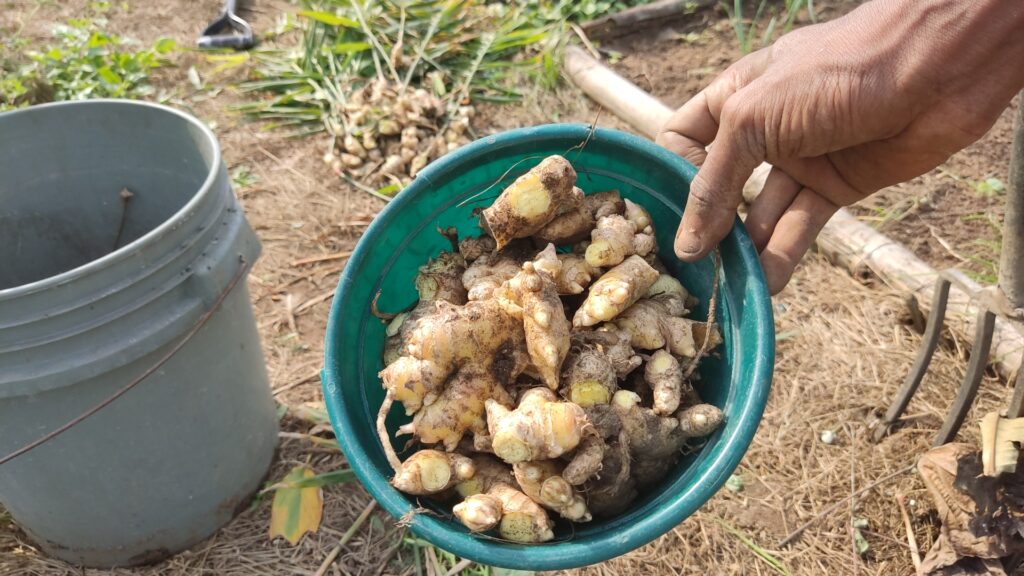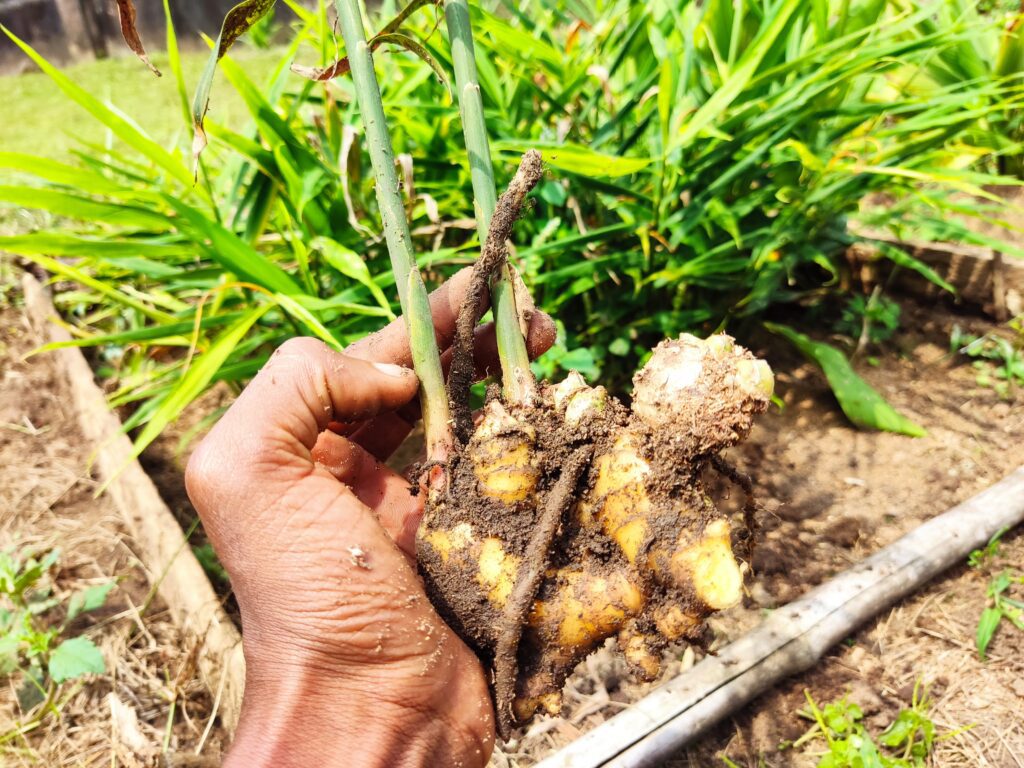About Ginger
Ginger with the botanical name Zingiber officinale is an herbaceous perennial plant of the family Zingiberaceae (which includes Turmeric and Cardamon) native to southeastern Asia. It is called Atale in Yoruba.
It has an aromatic, pungent rhizome (underground stem) used as a spice, flavoring, food, and medicine. To be used as a spice, it is dried, ground, and used to flavor bread, sauces, curry dishes, confections, pickles, and ginger ale. For cooking, fresh rhizome green ginger is used.
Ginger leaves are 6 to 12 inches long, elongate, alternate in two vertical rows, and arise from sheaths enwrapping the stem. The flowers are in dense conelike spikes about 1 inch thick and 2 to 3 inches long that is composed of overlapping green bracts, which may be edged with yellow. The leafy stems of ginger grow to about a meter high. It does not grow in the wild and can’t be grown from seed, but must be cultivated by dividing the root.

Nutritional Information about Ginger
Ginger is a spice that contains a fair amount of nutrients and is found essential in so many different purposes. Listed below are the nutrients found in 100grams:

Source: Wikipedia.org; USDA Food Data Central
Medicinal Properties and Health Benefits of Ginger
Ginger has been found to be useful in the human body. It helps in keeping proper and healthy living. Some of the health benefits are:
- It is high in gingerol, a substance with powerful anti-inflammatory and antioxidant properties.
- Just 1–1.5 grams of ginger can help prevent various types of nausea. This applies to sea sickness, chemotherapy-related nausea, nausea after surgery, and morning sickness.
- It appears to be effective at reducing the day-to-day progression of muscle pain, and may reduce exercise-induced muscle soreness.
- It is effective at reducing symptoms of osteoarthritis, which is a very common health problem.
- It has been shown to lower blood sugar levels and improve various heart disease risk factors in patients with type 2 diabetes.
- It appears to speed up the emptying of the stomach, which can be beneficial for people with indigestion and related stomach discomfort.
- It appears to be very effective against menstrual pain when taken at the beginning of the menstrual period.
- It help protects against age-related damage to the brain. It can also improve brain function in elderly women.
- It helps fight harmful bacteria, as well as the RSV virus, which could reduce your risk of infections.
How to Plant Ginger
Regardless of the variety, Ginger is propagated by planting rhizomes (rootstalk cuttings) and has been under this type of cultivation for so long that it no longer goes to seed. The size of the root cultivated affects how fast the it grows; the larger the size the better.
Whether you are dividing the roots of a crowded plant colony, planting a new plant, or moving an existing plant to a new area, proper planting/transplanting is necessary so that it continues to thrive in the garden.
Use these steps:
- Prepare a garden bed for the ginger by applying a 2-inch layer of compost and working it into the top 6 inches of soil. You may also add any other animal manure you have at your disposal.
- Cut the rhizome into 1- to 1½-inch pieces. Each piece should be plump with well-developed growth buds, or eyes. You may set aside the cut piece for a few days to allow the cut surface area to heal and form a callus.
- Plant the rhizomes 6 to 8 inches apart, 2 to 4 inches deep, and with the growth buds pointing upward. They can be planted whole or in smaller pieces with a couple of growing buds each.
- Water the bed thoroughly after planting/transplanting, moistening it to a 6-inch depth. Spread a 1- to 2-inch mulch layer over the bed to help preserve soil moisture between waterings.
Soil and Nutrient Requirements for Ginger
- The best soil for ginger is loose, loamy, and rich in organic matter. Loamy soils allow water to drain freely, which will help prevent the rhizomes from becoming waterlogged. Thick mulch can also provide nutrients, retain water, and help control weeds.
- It require mildly acidic soils for healthy growth and rhizome production. Ensure that your soil pH is between 5.5 and 6.5. If the soil pH is too high, it is too alkaline; if it is too low, it is too acidic and will interfere with ginger growth. Lower the soil pH by applying composted manure, or increase the pH with calcium carbonate or dolomite to achieve optimal pH.
- It prefers rich, fertile soil. Soil rich in organic matter provides ginger with the nutrients it needs to produce flavorful, healthy rhizomes.
- Moist, well-draining soil is optimal for ginger plants. It is important that the soil mixture hold moisture; however, it is important that it is not be exposed to overly saturated or waterlogged soil.
Sun Requirements
Ginger requires 2-5 hours of direct sunlight for proper growth and for maximum yield. Thus, it can grow under full and partial shades too. (Show clips of ginger in partial shades)
Watering Requirements
Ginger needs a lot of moisture while actively growing. Ginger requires water at least once per week but deeply. Do not allow the plants to dry out while they are actively growing. Don’t overwater, though, because the water that drains away will take nutrients with it. As the weather cools, reduce watering. In dry areas, mist or spray plants regularly.
Maturity, Harvesting, and Yield
Mature ginger rhizomes will generally be ready to be harvested in about 10-12 months, or after the leaves die back. At this juncture, the leaves have yellowed and dried and the stems are falling over. The rhizomes will have firmer skin that will bruise less easily when handling and washing.
When harvesting, you can choose to harvest the entire plant or you can just cut off what you need and allow the plant to continue growing.
If the entire plant is harvested, choose rhizomes for replanting and replant them promptly.
It is harvested by digging up the plant. Loosen the soil around the ginger plant with a spading fork and lift the ginger rhizomes out of the soil, leaving any foliage in place. The average yield of ginger is 6-10 tonnes/acre.

How to Store Ginger
Without peeling, ginger can be stored at room temperature in an environment free from moisture to prevent it from growing and also to prevent disease infestation.
Once you have peeled the ginger or sliced it into it, you can no longer store it at room temperature. To make it last longer, you will have to freeze or refrigerate it. It can easily last up to three weeks in the refrigerator, provided it has not been exposed to air and moisture.
Pest and Diseases that affects Ginger
- Bacterial Wilt: This is caused by bacteria and its symptoms include curling of infected leaves, leaves turning yellow and necrotic, plants becoming stunted and dying, and rhizomes being discolored and water-soaked. It can be managed naturally by planting ginger in well-drained soils where ginger had not been previously grown, planting disease-free varieties, planting ginger on hills to aid soil drainage, and promoting airflow around the rhizomes.
- Rhizome rot: This is a disease that causes stunted growth, yellow leaves and stems, brown discoloration of water-conducting tissues within the stem, and foul odor from rotten rhizomes. It is caused by oomycetes and it can be managed traditionally by planting rhizomes in hills to allow for good drainage, do not plant seeds that show symptoms of rot, treating seed pieces with hot water, destroy all crop debris after harvest.
- Chinese rose beetle: This insect causes holes in leaves and consumes the entire leaves with the exception of the veins. An adult insect is a reddish-brown beetle that feeds on plants at night. It can be controlled by shining bright light on plants, this helps to deter the insects as they are repelled by bright light, covering young plants with floating row covers.
- Root-Knot Nematode: This causes water-soaked lesions on roots, yellow leaves with a fewer number of shoots, and stunted growth. It is caused by nematodes and can be controlled culturally by planting resistant varieties and treating rhizomes with hot water before planting.
